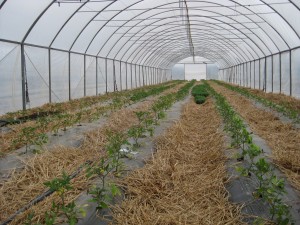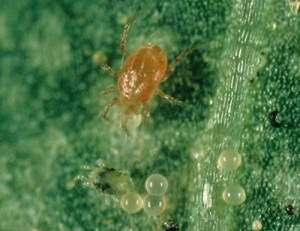Early local tomatoes are a plus for both farmers and consumers. More and more farmers are using simple hoop structures covered with a layer of plastic to grow early crops of heat-loving vegetables like tomatoes, peppers, and cucumbers.

They also get an advantage in managing some pests — especially diseases caused by fungi that affect the leaves and fruit. These fungal diseases love wet leaves, and because plants in the high tunnel don’t get rained on (they’re watered through a drip irrigation system), leaves stay dry. The diseases, common in field production, can’t get going.
High tunnels are great for avoiding diseases that thrive on wet leaves, but high tunnel production can favor some insect and mite pests that are only sporadic problems in the field — pests like thrips and spider mites. The same is true of diseases that thrive in high humidity — diseases like Botrytis, powdery mildew, and leaf mold.
But there are good IPM solutions for those pests as well. Growers can purchase and release beneficial mites and insects that eat both thrips and spider mites. Meanwhile, ventilating tunnels as needed helps keep those humidity-loving diseases at bay. So consumers get early produce that very often doesn’t need any sprays.

For more information, visit the Cornell High Tunnel web site.